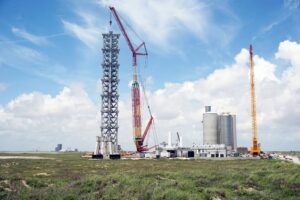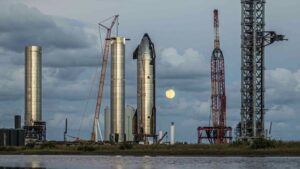
What Exactly Happened On Starship’s Third Launch Attempt?
After only 117 days since the last full Starship flight, the third attempt just took place and was by far the most impressive. Here we saw significant improvements from the past flight with a successful hot-stage separation, booster reentry, an upper-stage coast phase, and even upper-stage reentry. They even managed to complete a host of other tests related to future Starship operations. Here I will go more in-depth into what happened on this third flight test, where some issues arose, what went well, and more.
Third Launch Attempt

As the clock counted down, SpaceX confirmed that everything was a go for launch. They were a bit concerned about the weather and specifically the wind, however as the clock hit T- 40 seconds, they passed right through without the need for a hold. At T – 5 seconds, the water-cooled steel plate began shooting out water in preparation for liftoff. Seconds later the 33 Raptor engines on the booster began to ignite. By T + 2 seconds Starship was in the air and had fully cleared the pad by T +10 seconds.
Here it began accelerating into the slight overcast in Boca Chica Texas. You could see in the graphic provided at the bottom that all 33 Raptor engines were firing without any missing. Fortunately on this launch, SpaceX had multiple onboard cameras on both the booster and upper stage which provided some incredible images, especially later in the fight. At T + 52 seconds, the launch vehicle had reached Max Q (moment of peak mechanical stress on the rocket). Over the next nearly 2 minutes we saw different angles from both the ground and the ship looking down at the rocket as it accelerated and gained altitude.
It then reached one of its most significant flight milestones, stage separation. At T + 2:44 seconds, you can see both from the onboard camera and the engine graphic at the bottom that all but three of the booster’s Raptor engines shut off. Just a few seconds later, while still attached to the booster, the 6 upper stage engines ignited before the two finally separated just before T + 2:50 seconds into the launch. At this point, the booster began its flip maneuver while the upper stage started to accelerate and gain altitude.
This was the stage during the last test flight where problems arose that led to the explosion of the first stage. This time, however, there was a different result. At T + 2:52 seconds, the engine graphic shows that the 13 center Raptor engines on Super Heavy all began to light again for the boostback burn. Soon after around 3 minutes into the flight some incredible video was shown where the booster is horizontal and in the background you can see the upper stage continuing toward its insertion. Starting at T + 3:40 seconds, the booster’s 13 engines began to gradually shutoff as part of the boostback burn shutdown. During this process you could also partially see some significant venting from the bottom of the booster. Over the next few minutes, the upper stage continued to fire its engines while the booster shifted toward a vertical position in preparation for reentry. At T + 6:36 seconds, the booster was transonic and could be seen flying toward the ground and through the atmosphere. At that point, it began using its four grid fins to control its orientation and angle.
Officially, based on SpaceX’s provided flight profile, the booster landing burn startup was scheduled to happen right at T + 6:46 seconds. For the next 18 seconds, the engines were planned to slow the booster before a gradual splashdown in the Gulf. Looking at the footage, you can see the booster starting to spin back and forth as the grid fins work to keep the stage in the proper orientation. Soon after it passes the clouds before what looks like a possible explosion and the loss of signal to the booster. Right before that, the engine graphic showed that only three engines were lit, one in the very center, and two in the middle engine ring. Of these engines, the two in the middle ring were only lit for a second or two before going out. SpaceX later confirmed that the booster didn’t successfully complete the booster engine landing burn.
While all this was happening, the ship was still accelerating with all 6 of its engines lit. At T + 8:35 seconds, the 6 engines were shut off. At that point, the upper stage was at an altitude of 150km and traveling more than 26,000 km/h. In addition to the launch itself, SpaceX had a few in-flight tests planned which began around 12 minutes into flight. Specifically, at T + 11:58 seconds, flight controllers announced that the payload door had opened on Starship. This is a relatively small thin door that the company wanted to test assuming the vehicle made it into the coast phase. Later in the flight, a camera inside the upper stage showed the payload door closed. They also attempted a propellant transfer demo approximately 24 minutes into the flight. As far as whether or not these tests were fully successful will take time for SpaceX to determine and eventually release to the public.
All of this led to one of the final milestones, a Raptor engine relight and reentry. SpaceX clarified that the relight is not a deorbit burn and it actually would have raised the pedigree with this burn. It was just to demonstrate that they can relight the engine in space, microgravity, etc. This being said, they decided to skip that burn and go straight to reentry.
After a break in the live stream, right around 43 minutes into the flight SpaceX provided a live feed of the upper stage with onboard cameras. Over the next few minutes, you could see the fins adjust as the vehicle got closer to reentry. There also were a few moments where debris, what looked like heat shield tiles flying off. For example, 45 minutes into the flight a lot of tiles could be seen combined with a roar from the SpaceX crowd watching live. Just past T + 46 minutes, you could see the heating of the fins and ship start as it began reentry. The movement of the upper stage and its fins during this process suggests there could be an issue related to the vehicle’s attitude control and its general orientation. This continued to get more aggressive during the reentry process. By T + 47:14, incredible views of the ship and plasma forming could be seen. Just before 49 minutes in, the video feed was cut. By then, the vehicle was still reentering the atmosphere. Starship entry was scheduled to begin at T + 49 minutes with the vehicle finally making contact with the water around 15 minutes later.
A few minutes had passed and SpaceX wasn’t sure if the vehicle was still intact. They first mentioned that they lost connection with TDRSS (Tracking and Data Relay Satellite System) and Starlink at the same time. This was a good indicator that the vehicle had likely broken up during reentry. They later confirmed that they lost Ship 28 during reentry. Based on the footage we saw leading up to reentry with the heat shield tiles and debris, it’s very possible the ship lost a crucial amount of tiles before reentry leading to a weak point and eventual breakup. There also could have been an issue with the angle and exact orientation of Ship 28 which is crucial. Had the vehicle made it past reentry, it would have impacted the ocean and been destroyed either way.
Overall, SpaceX was extremely happy with the result of the launch and considered it a massive success. On the last flight, the booster was destroyed soon after stage separation and the upper stage nearly got to engine shutoff. This time, the booster made it all the way to the ground and the Ship got part of the way through reentry. Not only that, but they also completed a few tests during the flight which I mentioned prior. All of which will provide the company with a wealth of real flight data to apply to the next Starship prototypes and launch attempts.
In regard to this mission, the company was quoted saying, “The third flight test aims to build on what we’ve learned from previous flights while attempting a number of ambitious objectives. This rapid iterative development approach has been the basis for all of SpaceX’s major innovative advancements, including Falcon, Dragon, and Starlink. Recursive improvement is essential as we work to build a fully reusable transportation system capable of carrying both crew and cargo to Earth orbit, help humanity return to the Moon, and ultimately travel to Mars and beyond” they said.
With this test complete and the results promising, we can expect a fourth flight test relatively soon. To put it in perspective, the time between the first test flight and the second was 212 days. The time between the second test flight and the launch this morning was only 117. The improvements should also only help the approval process and launch prep for the next test. If that wasn’t enough, just over a month ago on February 2nd, the company tweeted saying, “Super Heavy boosters for the next three flights, with a fourth ready to stack, in the Starbase Megabay”. It’s clear they have the hardware needed to continue flying this vehicle at a rapid pace.
As for today’s test, we can expect SpaceX to release even more info over the next days and weeks. Teams will be busy analyzing everything that went well and didn’t, finding fixes, and implementing them. Something we can look forward to seeing in the coming months.
Conclusion
SpaceX just completed the third flight test of Starship, and it was quite the spectacle. From stage separation to the booster’s return, upper stage reentry, and much more, it was a big improvement from the past launches. We will have to wait and see how it progresses and the impact it has on the space industry.



